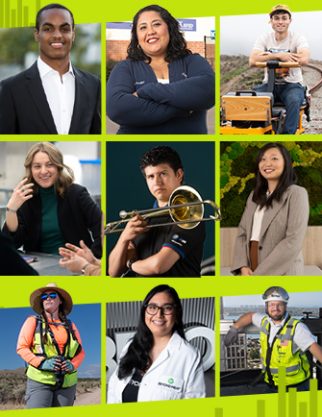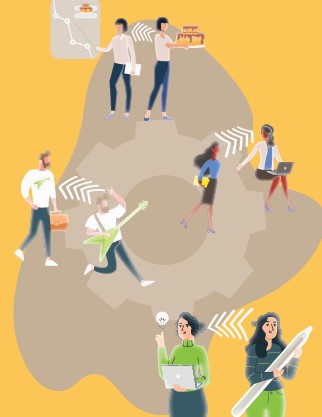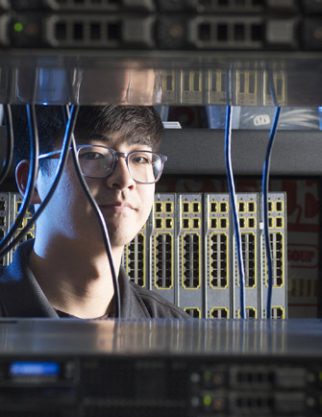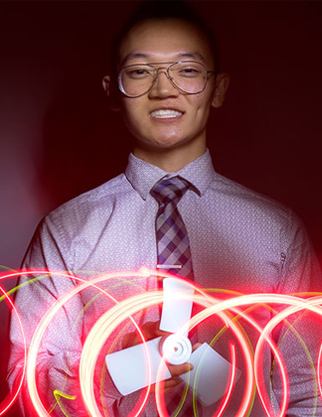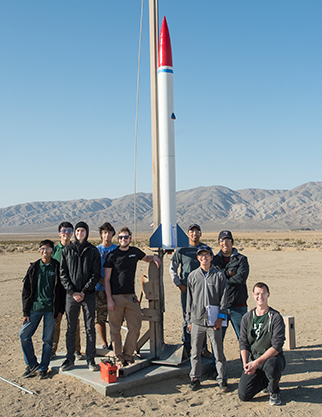Learning Curve
Stuffed animals and packed Zoom lectures, Blackboard-posted reading assignments and fairytale stories, online student group discussions and small children asking Daddy questions – all part of life these days for Peter Hanink.
Up until mid-March, the assistant professor of sociology and criminology managed to keep his home and campus lives separated. These days, however, it is not unusual for his course lectures to be interrupted by his 2-year-old daughter Maya climbing into his lap or the sound of his 5-year-old son Felix playing not far from the dining room table where he set up his virtual classroom.
Lesson No. 1: Learn to adapt when two worlds meet.
“Some of my students asked for a tour the of house. So, I took them out back and showed them my chickens,” says the Long Beach resident. “They got a kick out of that. I have showed them my unfolded laundry, and they got a kick out of that. They see toys everywhere.”
In response to the state’s order to shelter in place, Cal Poly Pomona joined other CSU campuses in moving all classes and exams to remote/virtual modes of instruction effective March 18. A temporary pause of all in-person instruction was put into effect for the preceding five days to give faculty an opportunity to prepare for the change.
For Hanink, the change to teaching remotely wasn’t too steep of a climb because he had taught online before. He already had Blackboard set up to share materials and assignments with students, he says.
But even for a professor adept at teaching online, the five days when he had to flip his classes to remote instruction went very quickly.
Lesson No. 2: Be flexible.
Hanink, struck by the speed of the transition and the limberness required to manage his various roles, penned an opinion piece in the student newspaper, “The Poly Post,” titled “From classrooms to chatrooms: A professor’s perspective on the transition to online classes.”
“Like many of your professors, I’ve taught classes online many times before,” he wrote. “What’s different this time is the circumstances. I don’t have weeks or months to read up on pedagogy and technology. I don’t have the opportunity to test out recording equipment and software. I don’t have the luxury of practice takes and retakes when a trash truck rolls by or the doorbell rings. No. Instead I have a few days, my laptop and my dining room table. And that means I’ll have to be more flexible.”
Hanink wrote the article after The Poly Post editor contacted his department looking for a faculty member’s perspective.
“I was interested in writing it because I had been having so many conversations with students and administrators about the transition,” he says, “and I thought I could maybe humanize the professors and shed some light into what we’re going through.”
Lesson No. 3: Exercise patience.
For Hanink, who teaches three classes of varying sizes on Monday and Wednesday afternoons, another important lesson is for students to give grace to faculty and for faculty to extend the same to students.
It’s not really realistic for us to be able to say to students that everybody must show up to a particular time or place in the same way that they do in a regular classroom,” Hanink says. “Their Wi-Fi might not be good, or they might be moving home. A lot of students have children, or they have younger brothers and sisters that they might be responsible for. I think we have had to be more flexible right now.
Hanink isn’t the only one learning as he goes. So are students.
Lesson No. 4: Try to remain calm under pressure.
Viviana Pacheco, a human resources senior, already knew the importance of flexibility.
Before the coronavirus pandemic struck, Pacheco’s life was already pulled in many directions as a fiancée, mother of two boys, a full-time student and a part-time intern. Since statewide stay-at-home orders went to effect, Pacheco is taking multitasking to a higher level. She is taking five classes this semester, with plans to graduate in the fall. She also works a 20-hour-a-week internship with Employee and Organizational Development and Advancement (EODA), the office on campus that provides professional development training and onboarding for faculty and staff.
With schools closed, Pacheco also must help her 6-year-old son Estevan with his work assignments while keeping her 2-year-old son Joel occupied.
“It hasn’t been easy,” Pacheco says. “I thought I would find a sort of structure, but I haven’t. It’s been day to day, especially with kids.”
Pacheco says that she has learned to respect her ability to multitask and tries not to put too much pressure on herself to get everything done by a set time. Her ability to withstand pressure was tested when her toddler woke up 15 minutes after she started a timed test for her business statistics class. Already anxious, Pacheco says she didn’t finish one of the problems on her test but did all that she could to get back on track after the interruption.
“Honestly, I did not know what to do,” she says of her son waking up. “He wanted attention, and at the time, I couldn’t give him the attention he needed. While I rushed to complete the test, a sense of comfort came when my oldest son, Estevan, tried to comfort Joel by letting him know that I was taking a test, that I was almost done, and that Joel should go and play with him in the room. It was the cutest thing.”
Lesson No. 5: Make time to connect with people.
Jenny Martinez, a mechanical engineering senior, says she initially embraced virtual classes. She took five classes in spring and plans to complete her final class in the summer.
“In the beginning, I loved it,” she says. “Now, I think is has been very challenging to be productive.”
Part of that struggle comes from the isolation of sheltering at home, she says.
With the exception of volunteering on Saturdays at the Pomona Valley Certified Farmers Market, a resource that provides food and educational activities to the community, Martinez says she doesn’t go out.
“We are social beings by nature, so I am trying to transition and make connections with people through the internet,” she says, adding that she recently took an online yoga class, with her friend joining her virtually.
I try to stay positive and find a new way, but it has been very challenging. I feel like we are not just working from home. We are going through a crisis while we’re trying to work.
For faculty, peer support has been key.
Back in early March, the decision to switch to remote/virtual instruction hadn’t been made yet, but it was clear that the university would move in that direction, according to Victoria Bhavsar, director of the Center for the Advancement of Faculty Excellence (CAFE).
Her team just happened to host a full-day professional development event for faculty on March 6, right before the change went into effect. To prepare the event and anticipating the possibility of remote/virtual teaching, the team put together a teaching continuity site in 48 hours to help make the transition as smooth as possible. MediaVision created videos on how to use Zoom and a similar video app called Kaltura, and the team conducted face-to-face workshops with faculty on March 9.
In addition to the ongoing trainings, the Faculty Center team sends daily emails to faculty filled with tips, pedagogy, and virtual office hours.
“I have the best team in the CSU,” Bhavsar says. “We already had a lot of resources that we had gathered together for our digital course design academy. We had developed the course design academy some years ago as part of our pandemic plan, and it was useful, but we quickly found that we needed a different format of resources for faculty.”
Most of the faculty seem to be making the transition without major issues so far, she says, adding that the focus is now ensuring that remote/virtual teaching and learning is sustainable and equitable, helping all students to succeed even in this extraordinary situation.
Lesson No. 6: Tap into your expertise to help others.
Paul Nissenson, an associate professor of mechanical engineering, has tapped into his extensive experience with developing online content to assist his colleagues who might not be as familiar with teaching virtually. He taught a massive open online course in 2014-15, routinely records his in-class lectures for students, has experimented with a flipped classroom teaching style, played a lead role in developing his department’s video tutorial library (ME Online), and recently started a podcast on the engineering student experience.
So when the university seemed to be heading toward online learning, Nissenson volunteered to put together and lead a crash course on virtual instruction for his fellow engineering faculty.
Nissenson says he just happened to be in the right place at the right time with some tools he knew other professors might be able to use. One thing he tries to emphasize with faculty is that they should be humble and ask the students for their feedback — How would the students rate the learning experience in this virtual environment?
“People are coming into these trainings with widely different levels of experience,” he says. “Some know 90 percent of what they need and only require a little help, and others have never used Blackboard before. With all of the effort the students have put into the semester, I don’t want that effort to go to waste.”
